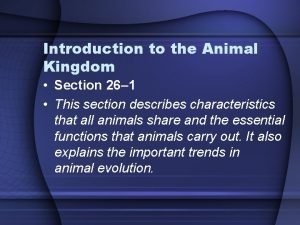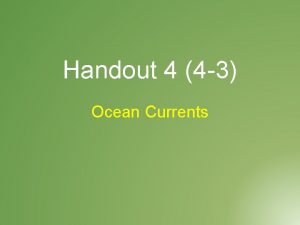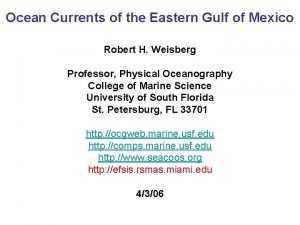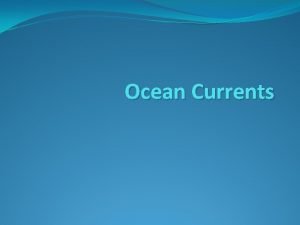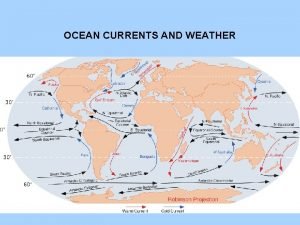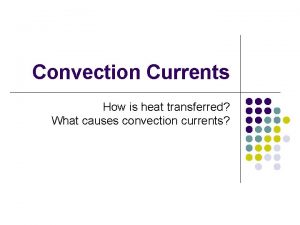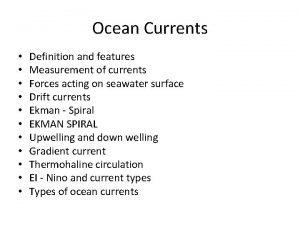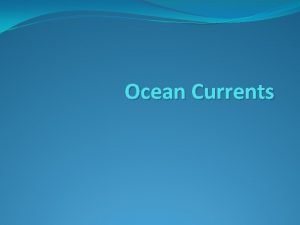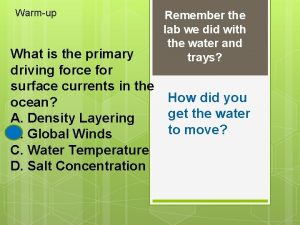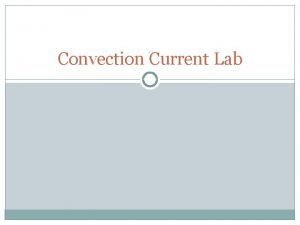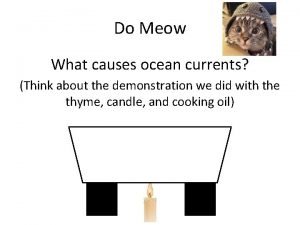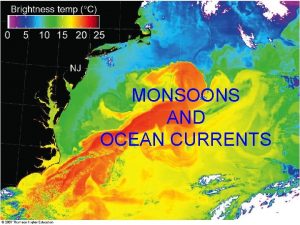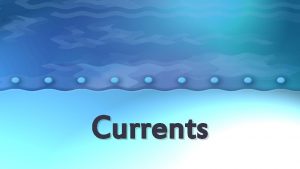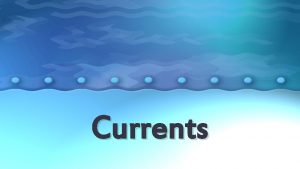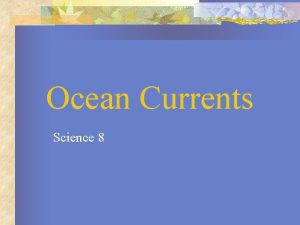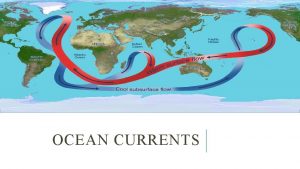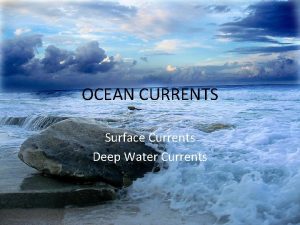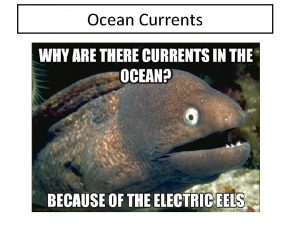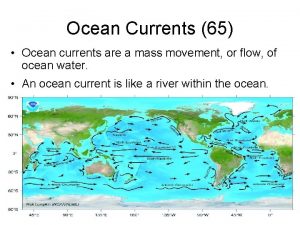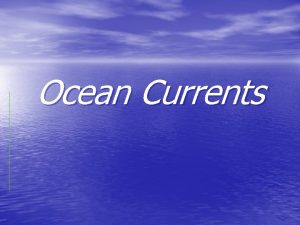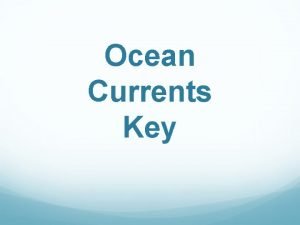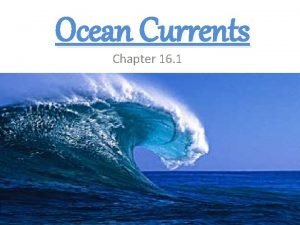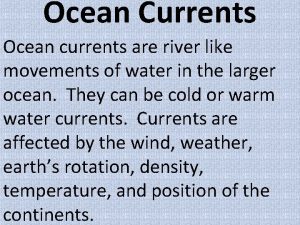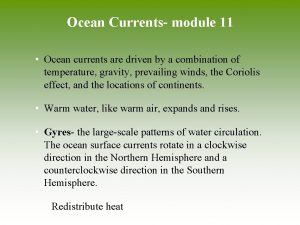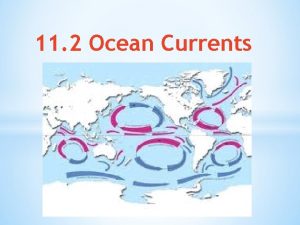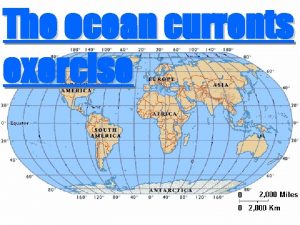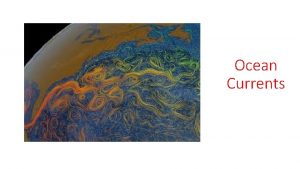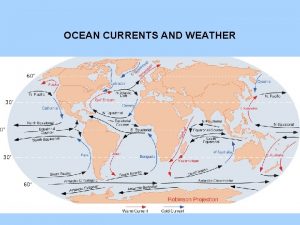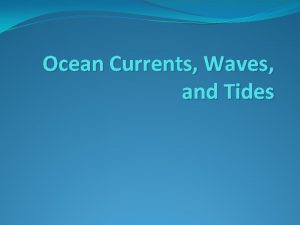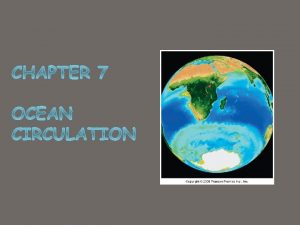Ocean currents move ocean animals around Small animals








































- Slides: 40

Ocean currents move ocean animals around. Small animals in the ocean can be pushed around currents, and may not be able to choose where to Adult fish and mammals can swim strongly, and a invertebrates cling to the bottom, but babies are a mercy of the currents.

Adult China Rockfish Juvenile Shortbelly Rockfish


Mary Nishimoto and Libe Washburn (UCSB), June 1998 Mary was interested in rockfish, hadn’t found any Libe saw a strong counter-clockwise eddy, 30 km across Surface currents up to 0. 4 m/s Eddy shows in sea surface temperature image All the fish were in the eddy Following year, eddy was weaker and moved around No high concentration of fish

Currents averaged May 1 – June 15 each year 1998 Summer 1998 Closed eddy, lots of fish 1999 Summer 1999 Open eddy, fewer fish


Standard ecological theory (land): Animals are found in comfortable environments Marine ecological theory: Animals may be found where the currents put them. Depends on animals lifestyle.

Life styles in the ocean: 1. Drifting – planktonic/pelagic 2. Swimming - nektonic 3. Attached - benthic

1. DRIFTERS Planktonic – passively drifting or weakly swimming organisms moved by ocean currents; include bacteria, phytoplankton, zooplankton Pelagic – of the open ocean, not site attached

Jellyfish, comb jellies, heteropods, pteropods, salps 0. 2 cm 70 cm 5 cm 1 cm

2. Swimmers organisms that swim actively in open water, independent of water currents.

3. ‘Attached’ organisms Benthic – ‘site’ attached, living attached to or on the ocean floor


Many marine species have ‘bipartite’ life historie 1. Planktonic dispersive early stage 2. 2. benthic or site attached adult stage PLANKTONIC LARVAE SETTLEMENT *Larva: an independent, often free-living, developmental stage that undergoes changes in form and size to mature into the adult; especially common in insects and aquatic organisms. (From a Latin word meaning "ghost" or "mask. ") REPRODUCTION BENTHIC ADULTS

More facts of nature: you don’t see the bipartite lifestyle often on land



Why is a bipartite life history interesting? For most marine species, we have NO idea where larvae go

Take-home points: • multiple life styles • most commonly, larvae are different from adults (bipartite life history) • do the larvae move to new adult habitats? (open population)

Larval Transport on Ocean Currents: • Determines where and when larval settle and become a • Affects where and when a given species is found.

An example from the Oregon Coast … Wind from the North, drives upwelling Ekman transport pushes water offshore Very few barnacles settle in intertidal A few days later … Wind relaxes or blows from South Ekman transport pushes water onshore Lots of barnacles settle in intertidal

The PISCO Project Cluster around Point Conception For dispersing larvae only

Biogeographic Representation Oregonian Transition Californian

Onshore Monitoring – Recruitment Examples of recruitment collectors




di Po se rt Co v H ue e ne m Ve e nt u St ra ea r El ns lw oo G d a Bo vio at ta ho us e Sa Av i n Si la m eo n ra Pa Boathouse Average number of settlers per collector per sample interval Average surface currents: 15 Jul 99 Late summer recruiter, 1997 -1999 Leptopecten latiauratus 18 16 14 12 10 8 6 4 2 0 poleward Gaviota Elwood

Tricolia sp. Average surface currents: 2 Jan 99 Tricolia sp. Boathouse poleward Gaviota Elwood

Review: Currents affect the spatial patterns of larval settlem Leptopectin (a scallop) spawns in late summer Larvae are affected by convergent circulation at Pt C Settlement is high only inside the SB Channel Tricolia (a snail) spawns in winter Larvae are affected by poleward circulation at Pt C Settlement is high inside and outside SB Channel These patterns make sense if all the larvae are spawned in

Larval Transport on Ocean Currents: • Determines where larval settle and become adults. • Affects where a given species is found. • Connects different habitats. Animals born in one place may spend their adult lives in a If you want to protect a species by creating a safe haven fishing), do you choose its larval or adult habitat? BIG question in design of marine reserves.


Review: Ocean currents affect where animals are Rockfish study in Santa Barbara Channel: • Juveniles gathered in strong eddy 1998 • Weaker eddy in 1999 did not result in high concentr • Did currents affect fish directly or by concentrating f Effect of currents depends on lifestyle: • Swimmers can go where they please • Animals and plants attached to bottom can resist cu • Drifters float on currents Many marine animals have bipartate lifestyle. Larval stage drifts, adults swim or attach to bottom.

Drifting of larval stages may determine where some species are found Marine organisms respond to currents as well as habitat quality (like temperature or salinity). Organisms on land respond only to habitat.


The organisms: Inter-tidal invertebrates: ( mussels, barnacles, crabs, …) - planktonic phase from hours to months - size: ~ 1 mm - weakly swimming or non-swimming - larvae may change vertical position in water column Fishes: (juvenile rockfishes and hake, lamp fishes, smooth tongue) - larval/juvenile stages: weeks to months - size: ~ few to several cm - swimming speeds: ~ few cm/s - daily vertical migrations: up to 100’s of m


Nearshore Moorings - Design Floats Collectors (4 Types) Fluorometer Current Meter Temperature Recorder


Take-home points: • multiple life styles • most commonly, larvae are different from adults (bipartite life history) • do the larvae move to new adult habitats? (open population) • implications for marine reserve design
 What is a deep current
What is a deep current 26-1 introduction to the animal kingdom answer key
26-1 introduction to the animal kingdom answer key Ocean currents map
Ocean currents map Ocean currents gulf of mexico
Ocean currents gulf of mexico Rubber ducks ocean currents activity
Rubber ducks ocean currents activity Brainpop climate types
Brainpop climate types Factors affecting climate
Factors affecting climate Ocean currents project
Ocean currents project Ocean currents vocabulary
Ocean currents vocabulary Www.gulfstreamshutdown.com
Www.gulfstreamshutdown.com Ocean currents
Ocean currents Ocean currents
Ocean currents What causes convection currents
What causes convection currents Currents definition
Currents definition What are ocean currents
What are ocean currents Ocean currents vocabulary
Ocean currents vocabulary Cold peruvian current
Cold peruvian current What is the primary driving force behind surface currents?
What is the primary driving force behind surface currents? Convection current definition
Convection current definition What are ocean currents
What are ocean currents Ocean currents
Ocean currents Citlalli dominguez
Citlalli dominguez Lateral thinking riddle
Lateral thinking riddle What goes around comes around examples
What goes around comes around examples Goes around comes around meaning
Goes around comes around meaning The very hungry caterpillar stomachache
The very hungry caterpillar stomachache Types of divergent plate boundary
Types of divergent plate boundary Red ocean vs blue ocean
Red ocean vs blue ocean Chapter 15 ocean water and ocean life wordwise answer key
Chapter 15 ocean water and ocean life wordwise answer key Ocean ocean convergent boundary
Ocean ocean convergent boundary Scrat s continental crack up
Scrat s continental crack up Ocean to ocean convergent boundary
Ocean to ocean convergent boundary Convergent oceanic oceanic plate boundary
Convergent oceanic oceanic plate boundary Ocean ocean convergent boundary
Ocean ocean convergent boundary Desert herbivores
Desert herbivores Consumer decomposer producer
Consumer decomposer producer Detritus food chain
Detritus food chain Animals that eat both plants and animals
Animals that eat both plants and animals Https//a-z-animals.com/animals
Https//a-z-animals.com/animals What is the primary cause of surface currents
What is the primary cause of surface currents Currents the band
Currents the band

